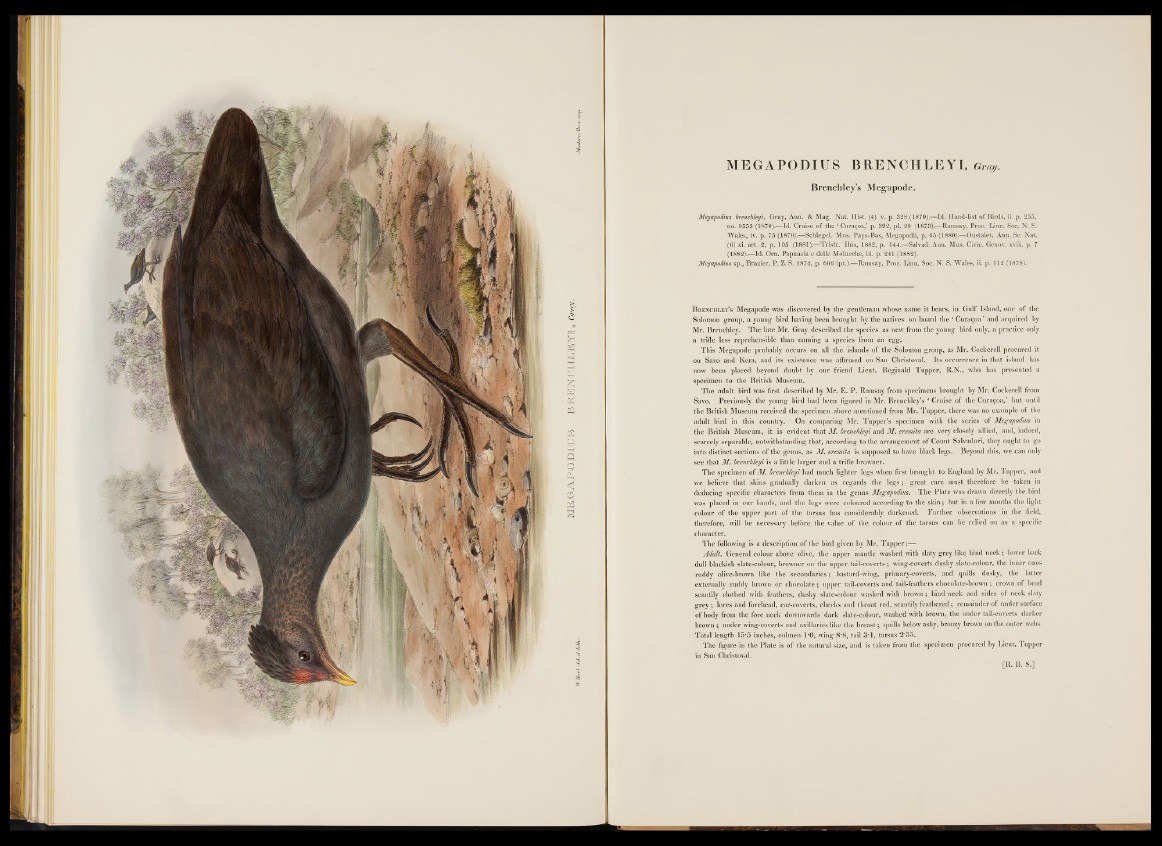
ME GAP Q DUCTS B B E S C H L E i l , Gray.
MEGAPODIUS BRENCHLEYI , Gray.
Brenchlev’s Megapode.
Megapodius brenchleyi, Gray, Ann. & Mag. Nat. Hist. (4) v. p. 328 (1870).—Id. Hand-list of Birds, ii. p. 255,
no. 9553 (1870).—Id. Cruise of the * Curaqoa,’ p. 392, pi. 20 (1873).—Ramsay, Proc. Linn. Soc. N. S.
Wales, iv. p. 75 (1879).—Schlegel, Musv Pays-Bas, Megapodii, p. 65 (1880).—Oustalet, Ann. Sc. Nat.
(6) xi. art. 2, p. 105 (1881).—Tristr. Ibis, 1882, p. 144.— Salvad. Ann. Mus. Civic. Genov, xviii. p. 7
(1882).—Id. Orn. Papuasia e delle Molucche, iii. p. 241 (1882).
Megapodius sp., Brazier, P. Z. S. 1874, p. 606 (pt.).—Ramsay, Proc. Linn. Soc. N. S. Wales, ii. p. 112 (1878).
B kenchley’s Megapode was discovered by the gentleman whose name it bears, in Gulf Island, one of the
Solomon group, a young bird having been brought by the natives on board the ‘ Cura^oa ’ and acquired by
Mr. Brenchley. The late Mr. Gray described the species as new from the young bird only, a practice only
a trifle less reprehensible than naming a species from an egg.
This Megapode probably occurs on all the islands of the Solomon group, as Mr. Cockerell procured it
on Savo and Kera, and its existence was affirmed on San Christoval. Its occurrence in that island has
now been placed beyond doubt by o ur friend Lieut. Reginald Tupper, R.N., who has presented a
specimen to the British Museum.
T h e adult bird was first described by Mr. E . P. Ramsay from specimens brought by Mr. Cockerell from
Savo. Previously the young bird had been figured in Mr. Brenchley’s ‘ Cruise o f the Cura9oa,’ but until
the British Museum received the specimen above mentioned from Mr. Tupper, there was no example o f the
adult bird in this country. On comparing Mr. Tupper’s specimen with the series of Megapodius in
the British Museum, it is evident th at M. brenchleyi and M. eremita are very closely allied, and, indeed,
scarcely separable, notwithstanding that, according to the arrangement o f Count Salvadori, they ought to go
into distinct sections o f the genus, as M. eremita is supposed to have black legs. Beyond this, we can only
see th at M . brenchleyi is a little larger and a trifle browner.
T h e specimen o f M. brenchleyi had much lighter legs when first brought to England by Mr. Tupper, and
we believe th at skins gradually darken as regards the l e g s ; great care must therefore he taken in
deducing specific characters from them in the genus Megapodius. T he Plate was drawn directly the bird
was placed in our hands, and the legs were coloured according to the s k in ; but in a few months the light
colour o f the upper p a rt o f the tarsus has considerably darkened. Fu rth e r observations in the field,
therefore, will he necessary before the value o f the colour o f the tarsus can be relied on as a specific
. character.
T h e following is a description o f the bird given by Mr. T u p p e r:—
Adult. General colour above olive, the upper mantle washed with slaty grey like hind neck ; lower back
dull blackish slate-colour, browner on the upper tail-coverts; wing-coverts dusky slate-colour, the inner ones
ruddy olive-brown like the secondaries; hastard-wing, primary-coverts, and quills dusky, the latter
externally ruddy brown o r chocolate; upper tail-coverts and tail-feathers chocolate-brown ; crown o f head
scantily clothed with feathers, dusky slate-colour washed with brown ; hind neck and sides o f neck slaty
grey ; lores and forehead, ear-coverts, cheeks and throat red, scantily fea th e red ; remainder o f under surface
o f body from the fore neck downwards dark slate-colour, washed with brown, the under tail-coverts darker
brown ; under wing-coverts and axillaries like the b r e a s t; quills below ashy, bronzy brown on the outer webs.
Total length 15*5 inches, culmen 1*0, wing 8*8, tail 3*1, tarsus 2*55.
T h e figure in the Plate is o f the natural size, and is taken from the specimen procured by Lieut. Tupper
in San Christoviii.